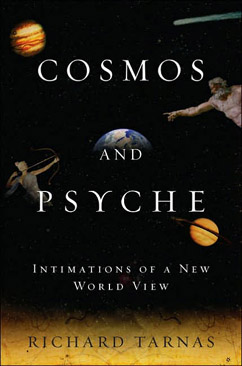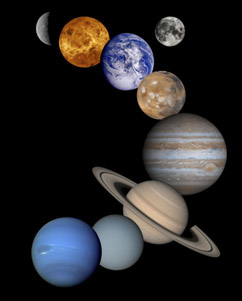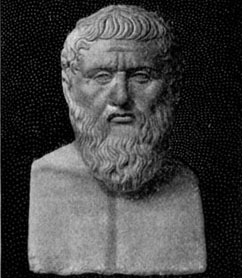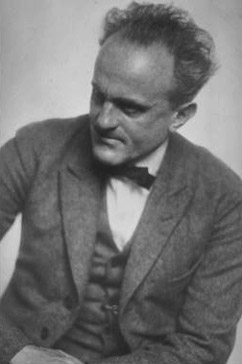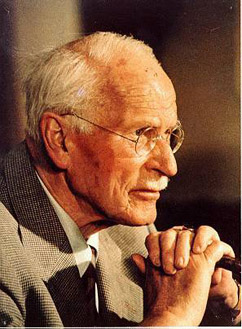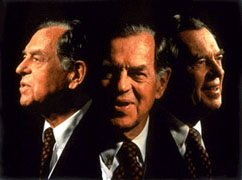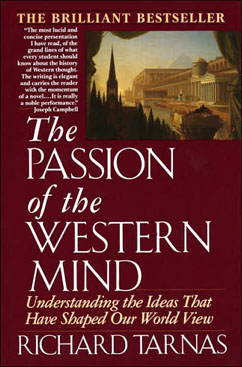Book
Review
Cosmos
and Psyche:
Intimations of a New World View
by
Richard Tarnas,
Penguin Group, 2006
(paperback by Plume, 2007).
Reviewed by John Townley
When
the author of the ultimate university humanities textbook
(The Passion of
the Western Mind)
turns his full attention to astrology and proclaims it to be the
newest,
greatest, most revolutionary page in Western philosophy, the world
should sit
up and take note. At least, that part of the world which can fully get
its head
around 500+ pages of a redefinition of our world-view largely justified
personal experience backed by
lengthy correlation of planetary cycle periods and social trends.
Because of
its size and complexity, it does run the risk of sharing the
prestigiously
unread coffee-table fate of Steven Hawking’s A Brief
History of Time.
But
take heart –
once you get through the first 150 pages of
the carefully-argued premise (and that’s essential) and a
simple
introduction to astrology for the general reader, the rest is
an enjoyable,
scenic ride through planetary history, much of which is refreshing
addition and
expansion to what great mundane astrologers like Charles Jayne,
Grant Lewi,
Dane Rudhyar, and others have been saying for a century or so, seen
through a
pair of fresh eyes. Unfortunately, too many astrologers will be
inclined to
skip the tough part, thinking they already accept the principles of
astrology, but
they shouldn’t. They shouldn’t, because Tarnas is
proposing
to the rest of the world
a raison
d’etre for astrology
that
astrologers should look at twice, before they buy into his version in
the way
too many have previously bought into Jung’s. The arguments
are
dense, intellectual,
and sweeping, but he makes some presumptions and conclusions not all
astrologers (or scientists) might or should accept.
At the
heart of
Tarnas’s thesis is a modern humanistic struggle:
the centuries-long schism between science and religion leading to the
nihilistic version of life that has resulted, as the most soulless,
reductionist visions of science triumphed to lead Western thought,
leaving
mainly fundamentalist religion and escapist spiritualism as the
alternative.
There’s a terrible disconnect between the inner and outer
worlds
in which the
latter has largely eclipsed the former except in its most extreme
forms. It’s
kind of like you can have Uranus or Neptune, but not both, and
that’s a
lose-lose option for life. He explains in detail, philosopher by
philosopher,
how we got stuck with this, from Descartes to post-modernism, and
demonstrates
familiarly how in the separation between science and religion, and
church and
state, astrology became the baby thrown out with the bathwater because
it
insisted on unity, thus earning the current rejection of both sides.
Over a
lifetime of
observations correlating planetary
positions with events, both inner and outer, Tarnas has come to the
conclusion
that you can
have both, and that the
inner and outer human worlds are
connected, albeit loosely, through the really big outer world of the
planets and
their movements. In other words, like most astrologers who started out
as
skeptics, he learned from simple experience that “astrology
works,” because of
the too-high coincidence of planetary events with human ones,
individually and collectively.
Reading the account of his personal journey is a pleasure, because
we’ve all
been there and he explains it so clearly and sympathetically to the
non-astrological reader. The problem to solve, as always, is how does
the one
connect with the other, the outside with the inside, or is an
explanation necessary
at all? Are the often-mysterious “synchronistic”
correlations that suffuse
astrology somehow directly causally related or are they merely complex
systems
running in parallel, only serendipitously associated? Is it mostly a
projection
of our imagination, or is our imagination (and events in tandem) at
least partly
projected from elsewhere?
That
same journey was
taken by two scientists in the early
twentieth century, biologist Paul Kammerer
and psychologist Carl Jung.
The
former suggested the solution lay in external natural law of a higher
complexity than previously observed (presaging chaos theory), the
latter
suggested that there was a greater, inner world that was calling the
shots at a
higher, “archtypical” level. For a variety of
socio-political reasons, too
complicated and often devious to get into here, Jung’s vision
dominated,
primarily because it cloaked itself in the growing shelter of modern
psychology, one of the only “sciences” left which
didn’t have to answer to more
reductionist, laboratory versions of science. Thus,
“synchronicity” and the
idea of “archetypes” underneath it became labelled
a
fundamentally subjective
phenomenon, as Jung himself defined it. In search of some shred of
establishment
support in a world of rejection by science and religion alike, many
modern astrologers
took up this point of view as an explanation of and framework for
astrology. In
the end, modern astrology has thus predominately painted itself as an
historical anthropomorphism of the planets, the projection of our own
internal
(and apparently, somehow, freestanding) mythological
“archetypes.”
Tarnas
actually appears
to see beyond this, almost, as he
continually points out that although synchronistic events have a large
internal
component that seems to provide meaning from within, they actually
coincide
with real external trends which define meaning from without. In other
words, the
planets do seem to be running in tandem with human events, but without
a
suggested linking mechanism. To find that mechanism, however, he goes
right
back to a set of anthropomorphic planetary
“archetypes” to
explain it all, and
in the process claims it to be thus an “ensouled”
system
that puts the human
connection back into the cosmos. The archetypes float numinously above
both
planets and humankind so that they compel both, but are necessarily at
least
half human-derived and contextual. So, after first decrying
anthropomorphism,
he returns to it as part of a fundamental premise. Had he gone a simple
step
further – to say that since planetary rhythms have been the
original,
persistent forces predating human existence, anything subjective we
have to
provide must necessarily derive from them – he would have
capped
the issue. It
could be they don’t just reflect
our
meaning and “soul,” they are the drivers and
progenitors of
it. We got it from
them, and they continue to entrain what they spawned and will do so
long after
we’re gone. But Tarnas doesn’t go there.
What he
gets really
right, and argues clearly, is that
planets seem to carry with them large and amorphous yet very central
meanings,
like proto-concepts which move on their own and drag our specific
associations
along with them, which vary from application to application, in context
and in
combination with each other. But by using the recently-muddied term
“archetypes” he tends to lose his focus that the
planetary
archetypes are
really the only
ones the term applies
to, or that they are at least quite different and more fundamental than
the
host of other specific non-planetary archetypes established and
outlined by the
likes of Jung and Joseph Campbell. That’s a shame, because
apples
and oranges
are thus allowed to slip into the same crate, confusing the issue.
Would that
he had chosen or invented another word (protoconcept? dynalogue?) and
bent it
to his own, fresh definition.
These
are real
fundamental questions astrologers should
entertain before using Tarnas as the new Jung to hitch their wagons to
(as is
happening already – he’s becoming quite an icon).
But non-astrologers
are really his target for this book, and that is
why he has spent the majority of it carefully and lovingly showing the
synchronous development of Western civilization and major planetary
configurations. Regardless of a final, yet-to-be-determined mechanism
for the
link between the planets and human events, if there is this much
correspondence
between them (about 350 pp. worth, and that’s only a start),
there’s so much
smoke here there’s got to be fire somewhere. That’s
the
message the average
reader (at least, the one who makes it through the first part of the
book) will
take away, and it is one which astrologers should welcome and cherish.
Although
he deals early but only briefly with shorter, personal cycles like
Saturn’s,
his main focus is on the longer middle and outer planetary cycles and
their
association with socio-political development and the evolution of
civilization
and humanity at large. After all, that is where he was coming from to
begin
with, and why his previous book is an established college text,
entirely
outside of astrology.
Ultimately,
what this
book may do is help readers re-understand
the kind of unifying thinking that allows the generally obvious to
govern the
locally specific, the evolutionary principles that ultimately hold the
extremes
of science and religion in check, in service of practical survival and,
hopefully, progress. And, like Benson Bobrick’s
recent
popular history of
astrology The
Fated Sky, it may help
put the general public back on track to understanding that astrologers,
and
astrology, have been addressing it all along – and, to a
larger
degree than
most understand, have gotten it right.
 Richard
Tarnas was born in 1950 in Geneva,
Switzerland, of American parents. He grew up in
Michigan,
where he
studied Greek, Latin, and the classics under the
Jesuits. In
1968 he
entered Harvard, where he studied Western intellectual and cultural
history and
depth psychology, graduating with an A.B. cum laude in
1972. For ten
years he lived and worked at Esalen Institute in Big Sur, California,
studying
with Joseph Campbell, Gregory Bateson, Huston Smith, and Stanislav
Grof, and
later served as director of programs and
education. He
received his
Ph.D. from Saybrook Institute in 1976. From 1980 to
1990, he
wrote The
Passion of the Western Mind, a
narrative history of Western thought
which
became a best seller and continues to be a widely used text in
universities
throughout the world. He is the founding director of
the
graduate
program in Philosophy, Cosmology, and Consciousness at the California
Institute
of Integral Studies in San Francisco, where he currently
teaches. He
also teaches on the faculty of the Pacifica Graduate Institute in Santa
Barbara, and gives many public lectures and workshops in the U.S. and
abroad. Richard
Tarnas was born in 1950 in Geneva,
Switzerland, of American parents. He grew up in
Michigan,
where he
studied Greek, Latin, and the classics under the
Jesuits. In
1968 he
entered Harvard, where he studied Western intellectual and cultural
history and
depth psychology, graduating with an A.B. cum laude in
1972. For ten
years he lived and worked at Esalen Institute in Big Sur, California,
studying
with Joseph Campbell, Gregory Bateson, Huston Smith, and Stanislav
Grof, and
later served as director of programs and
education. He
received his
Ph.D. from Saybrook Institute in 1976. From 1980 to
1990, he
wrote The
Passion of the Western Mind, a
narrative history of Western thought
which
became a best seller and continues to be a widely used text in
universities
throughout the world. He is the founding director of
the
graduate
program in Philosophy, Cosmology, and Consciousness at the California
Institute
of Integral Studies in San Francisco, where he currently
teaches. He
also teaches on the faculty of the Pacifica Graduate Institute in Santa
Barbara, and gives many public lectures and workshops in the U.S. and
abroad.
|

